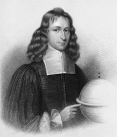EXAMPLE 9Finding the Power Series Representation for tan−1x
Show that the power series representation for tan−1x is \bbox[5px, border:1px solid black, #F9F7ED]{\bbox[#FAF8ED,5pt]{ \tan ^{-1}x=x-\dfrac{x^{3}}{3}+\dfrac{x^{5}}{5}-\dfrac{ x^{7}}{7}+\cdots +(-1)^{n}\dfrac{x^{2n+1}}{2n+1}+\cdots =\sum\limits_{k\,=\,0}^{\infty }\dfrac{(-1) ^{k}x^{2k+1}}{2k+1} }}
The power series representation for \tan^{-1}x is called Gregory’s series (or Gregory–Leibniz series or Madhava–Gregory series). James Gregory (1638–1675) was a Scottish mathematician. His mother, Janet Anderson, was his teacher and taught him geometry. Gregory, like many other mathematicians of his time, was searching for a good way to approximate \pi, a result of which was Gregory’s series. Gregory was also a major contributor to the theory of optics, and he is credited with inventing the reflective telescope.

Find the radius of convergence and the interval of convergence.
Solution If y=\tan ^{-1}x, then y^\prime =\dfrac{1}{1+x^{2}}, which is the sum of the geometric series \sum\limits_{k\,=\,0}^{\infty}(-1) ^{k}x^{2k}. That is, \dfrac{1}{1+x^{2}}=\sum\limits_{k\,=\,0}^{\infty }(-1) ^{k}x^{2k}=1-x^{2}+x^{4}-x^{6}+\cdots\,
This series converges when \vert x^{2}\vert < 1, or equivalently for -1 < x < 1. We use the integration property of power series to integrate y^\prime =\dfrac{1}{1+x^{2}} and obtain a series for y=\tan ^{-1}x. \begin{eqnarray*} \int_{0}^{x}\frac{dt}{1+t^{2}} &=&\int_{0}^{x}(1-t^{2}+t^{4}-\cdots)\, dt \nonumber \\ \tan ^{-1}x &=& x-\frac{x^{3}}{3}+\frac{x^{5}}{5}-\frac{x^{7}}{7}+\cdots +(-1)^{n}\frac{x^{2n+1}}{2n+1}+\cdots = \sum\limits_{k\,=\,0}^{\infty }(-1) ^{k}\dfrac{x^{2k+1}}{2k+1} \end{eqnarray*}
The radius of convergence is 1. To find the interval of convergence, we check x=-1 and x=1. For x=-1, -1+\frac{1}{3}-\frac{1}{5}+\frac{1}{7}-\cdots
For x=1, we get 1-\frac{1}{3}+\frac{1}{5}-\frac{1}{7}+\cdots
Both of these series satisfy the two conditions of the Alternating Series Test, and so each one converges. The interval of convergence is the closed interval [-1,\,1] .